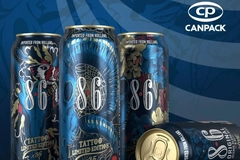Linpac Innovation Helps Shoppers to Cut Food Waste

The MAP techniques used in the packaging manufacturing reduce spoilage and contamination and enable a longer storage period by extending the shelf life of the packed foodstuff. The meat will remain fresh and attractive, and ultimately safer, for longer.
Mar 1 2012 --- LINPAC Packaging, Europe’s leading multi-material packaging manufacturer, is helping consumers reduce the food waste they generate at home by developing a range of split packs for both fresh and cooked meats.
The packs, which allow contents to be divided into separate portion-size compartments, in modified atmosphere packaging (MAP), mean consumers can store food in the fridge for longer without compromising food safety. The packs are particularly ideal for one or two-person households and are proving to be good value for consumers in the supermarket.
LINPAC is one of only a few food packaging companies to manufacture both films and trays for MAP applications and the split pack design is a showcase of their expertise in this area. A pack for fresh meat is already available to retailers and packers in the Iberian region, with plans to roll the innovative design out across Europe in the coming months. Meanwhile, a multi-pack for cooked meats is also being developed for the protein packaging market for the European summer barbeque season in 2012.
Alan Davey, Director of Innovation, at LINPAC Packaging, said: “The amount of food wasted every year is still too high. It is estimated that each person within the EU wastes 179kg every year, totalling in excess of 89 million tonnes. That figure is expected to rise by 40% by 2020 if no further action is taken to minimise the amount we throw away.
“A study into food waste funded by the EU estimates that households are responsible for 42% of the food waste issue, whereas consumers often see it as a supply chain problem. Clearly, while food waste remains such a major problem for the environment, it is essential for all the links in the food supply chain to play their part in preventing food waste. At LINPAC we are acutely aware of our role in helping consumers to minimise waste by designing innovative packaging solutions which enable them to only select the food they want to use and in maximising the shelf life of stored products in their homes.
“Well-designed packaging can help consumers buy the right amount of food and then keep it in the best condition for longer. LINPAC’s split packs for example, are designed so that the consumer can buy a tray of four chicken fillets for example, open one side of the pack and use two of them, then put the remaining two back in the fridge in a pack which is still completely sealed, with all the properties of an unopened pack.”
The MAP techniques used in the packaging manufacturing reduce spoilage and contamination and enable a longer storage period by extending the shelf life of the packed foodstuff. The meat will remain fresh and attractive, and ultimately safer, for longer.
Using the correct MAP conditions, the shelf life of fresh poultry can typically be increased from around four to seven days to between 16 and 21 days under refrigeration, while that of red meat can increase from two to four days to between five and eight days, depending on pack design. Where cooked or processed meats are packed in modified atmosphere packaging, shelf life increases from two to four days to between two to five weeks.
The most popular range of films for MAP applications available from LINPAC is LINtop HB, a high quality performance barrier film ideal for high gas barrier lidding. It is designed specifically to work in conjunction with the LINPAC range of rigid and foam trays. Anti-fog properties and maximum transparency are trademark features which offer the retailer good shelf presence and enhanced product presentation.
LINtop HB is made from the lowest gauge of film necessary to meet environmental requirements and is suitable for all types of top sealing machinery, helping packers to offer retailers a competitively priced packaging solution guaranteed to extend shelf life.
“We are confident that these packs will prove popular with both consumers and retailers,” said Mr Davey. “The benefits they offer to both parties are clear. Awareness of the food waste issue is low, particularly by householders and we believe that these packs will help consumers become more aware and subtly help to change their behaviour to reduce the amount of food they throw away.”











